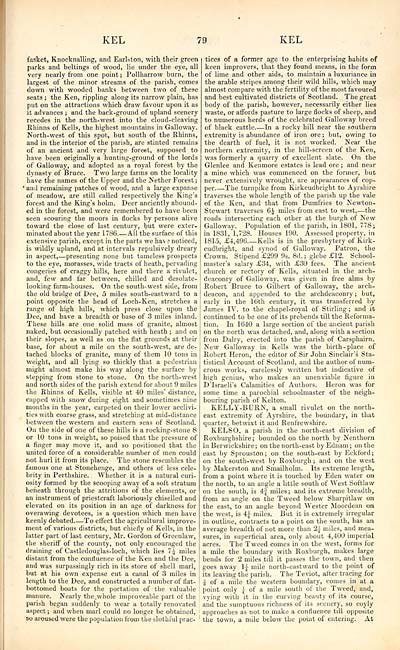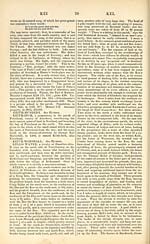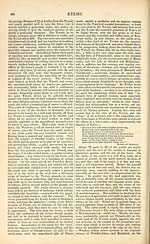Download files
Complete book:
Individual page:
Thumbnail gallery: Grid view | List view

KEL
79
KEL
fasket, Knocknalling, and EarUton, with their green
parks and beltings of wood, lie under the eye, all
very nearly from one point ; Pollharrow burn, the
largest of the minor streams of the parish, comes
down with wooded banks between two of these
seats ; the Ken, rippling along its narrow plain, has
put on the attractions which draw favour upon it as
it advances ; and the back-ground of upland scenery
recedes in the north-west into the cloud-cleaving
Rhinns of Kells, the highest mountains in Galloway.
North-west of this spot, but south of the Rhinns,
and in the interior of the parish, are stinted remains
of an ancient and very large forest, supposed to
have been originally a hunting-ground of the lords
of Galloway, and adopted as a royal forest by the
dynasty of Bruce. Two large farms on the locality
have the names of the Upper and the Nether Forest ;
'ami remaining patches of wood, and a large expanse
of meadow, are still called respectively the King's
forest and the King's holm. Deer anciently abound-
ed in the forest, and were remembered to have been
seen scouring the moors in flocks by persons alive
toward the close of last century, but were exter-
minated about the year 1786. — All the surface of this
extensive parish, except in the parts we hav? noticed,
is wildly upland, and at intervals repulsively dreary
in aspect, —presenting none but tameless prospects
to the eye, morasses, wide tracts of heatb, pervading
congeries of craggy hills, here and there a rivulet,
and, few and far between, chilled and desolate-
looking farm-houses. On the south-west side, from
the old bridge of Dee, 5 miles south-eastward to a
point opposite the head of Loch-Ken, stretches a
range of high hills, which press close upon the
Dee, and have a breadth or base of 3 miles inland.
These hills are one solid mass of granite, almost
naked, but occasionally patched with heath ; and on
their slopes, as well as on the flat grounds at their
base, for about a mile on the south-west, are de-
tached blocks of granite, many of them 10 tons in
weight, and all lying so thickly that a pedestrian
might almost make his way along the surface by
stepping from stone to stone. On the north-west
and north sides of the parish extend for about 9 miles
the Rhinns of Kells, visible at 40 miles' distance,
capped with snow during eight and sometimes nine
months in the year, carpeted on their lower acclivi-
ties with coarse grass, and stretching at mid-distance
between the western and eastern seas of Scotland.
On the side of one of these hills is a rocking-stone 8
or 10 tons in weight, so poised that the pressure of
a finger may move it, and so positioned that the
united force of a considerable number of men could
not hurl it from its place. The stone resembles the
famous one at Stonehenge, and others of less cele-
brity in Perthshire. Whether it is a natural curi-
osity formed by the scooping away of a soft stratum
beneath through the attritions of the elements, or
an instrument of priestcraft laboriously chiselled and
elevated on its position in an age of darkness for
overawing devotees, is a question which men have
keenly debated To effect the agricultural improve-
ment of various districts, but chiefly of Kells, in the
latter part of last century, Mr. Gordon of Greenlaw,
the sheriff of the county, not only encouraged the
draining of Castledouglas-loch, which lies l\ miles
distant from the confluence of the Ken and the Dee,
and was surpassingly rich in its store of shell marl,
but at his own expense cut a canal of 3 miles in
length to the Dee, and constructed a number of flat- I
bottomed boats for the portation of the valuable :
manure. Nearly the, whole improveable part of the
parish began suddenly to wear a totally renovated
aspect; and when marl could no longer be obtained,
so aroused were the population from the slothful prac- '
tices of a former age to the enterprising habits of
keen improvers, that they found means, in the form
of lime and other aids, to maintain a luxuriance in
the arable stripes among their wild hills, which may
almost compare with the fertility of the most favoured
and best cultivated districts of Scotland. The great
body of the parish, however, necessarily either lies
waste, or affords pasture to large flocks of sheep, and
to numerous herds of the celebrated Galloway breed
of black cattle.— In a rocky hill near the southern
extremity is abundance of iron ore; but, owing to
the dearth of fuel, it is not worked. Near the
northern extremity, in the hill-screen of the Ken,
was formerly a quarry of excellent slate. On the
Glenlee and Kenmore estates is lead ore ; and near
a mine which was commenced on the former, but
never extensively wrought, are appearances of cop-
per. — The turnpike from Kirkcudbright to Ayrshire
traverses the whole length of the parish up the vale
of the Ken, and that from Dumfries to Newton-
Stewart traverses 6£ miles from east to west, — the
roads intersecting each other at the burgh of New
Galloway. Population of the parish, in 1801, 778;
in 1831, 1,728. Houses 190. Assessed property, in
1815, £4,496 Kells is in the presbytery of Kirk-
cudbright, and synod of Galloway. Patron, the
Crown. Stipend £299 9s. 8d.; glebe £12. School-
master's salary £34, with £30 fees. The ancient
church or rectory of Kells, situated in the arch-
deaconry of Galloway, was given in free alms by
Robert Bruce to Gilbert of Galloway, the arch-
deacon, and appended to the archdeaconry ; but,
early in the 16th century, it was transferred by
James IV. to the chapel-royal of Stirling ; and it
continued to be one of its prebends till the Reforma-
tion. In 1640 a large section of the ancient parish
on the north was detached, and, along with a section
from Dairy, erected into the parish of Carsphairn.
New Galloway in Kells was the birth-place of
Robert Heron, the editor of Sir John Sinclair's' Sta-
tistical Account of Scotland, and the author of num-
erous works, carelessly written but indicative of
high genius, who makes an unenviable figure in
D'Israeli's Calamities of Authors. Heron was for
some time a parochial schoolmaster of the neigh-
bouring parish of Kelton.
KELLY-BURN, a small rivulet on the north-
east extremity of Ayrshire, the boundary, in that
quarter, betwixt it and Renfrewshire.
KELSO, a parish in the north-east division of
Roxburghshire ; bounded on the north by Nenthorn
in Berwickshire; on the north-east by Ednam; on the
east by Sprouston; on the south-east by Eckford;
on the south-west by Roxburgh ; and on the west
by Makerston and Smailholm. Its extreme length,
from a point where it is touched by Eden water on
the north, to an angle a little south of West Softlaw
on the south, is 4^ miles; and its extreme breadth,
from an angle on the Tweed below Sharpitlaw on
the east, to an angle beyond Wester Moordean on
the west, is i\ miles. But it is extremely irregular
in outline, contracts to a point on the south, has an
average breadth of not more than 2} miles, and mea-
sures, in superficial area, only about 4,400 imperial
acres. The Tweed comes in on the west, forms for
a mile the boundary with Roxburgh, makes large
bends for 2 miles till it passes the town, and then
goes away 1| mile north-eastward to the point of
its leaving the parish. The Teviot, after tracing for
J of a mile the western boundary, comes in at a
point only y of a mile south of the Tweed, and,
vying with it in the curving beauty of its course,
and the sumptuous richness of its scenery, so coyly
approaches as not to make a confluence tdl opposite
the town, a mile below the point of entering. At
79
KEL
fasket, Knocknalling, and EarUton, with their green
parks and beltings of wood, lie under the eye, all
very nearly from one point ; Pollharrow burn, the
largest of the minor streams of the parish, comes
down with wooded banks between two of these
seats ; the Ken, rippling along its narrow plain, has
put on the attractions which draw favour upon it as
it advances ; and the back-ground of upland scenery
recedes in the north-west into the cloud-cleaving
Rhinns of Kells, the highest mountains in Galloway.
North-west of this spot, but south of the Rhinns,
and in the interior of the parish, are stinted remains
of an ancient and very large forest, supposed to
have been originally a hunting-ground of the lords
of Galloway, and adopted as a royal forest by the
dynasty of Bruce. Two large farms on the locality
have the names of the Upper and the Nether Forest ;
'ami remaining patches of wood, and a large expanse
of meadow, are still called respectively the King's
forest and the King's holm. Deer anciently abound-
ed in the forest, and were remembered to have been
seen scouring the moors in flocks by persons alive
toward the close of last century, but were exter-
minated about the year 1786. — All the surface of this
extensive parish, except in the parts we hav? noticed,
is wildly upland, and at intervals repulsively dreary
in aspect, —presenting none but tameless prospects
to the eye, morasses, wide tracts of heatb, pervading
congeries of craggy hills, here and there a rivulet,
and, few and far between, chilled and desolate-
looking farm-houses. On the south-west side, from
the old bridge of Dee, 5 miles south-eastward to a
point opposite the head of Loch-Ken, stretches a
range of high hills, which press close upon the
Dee, and have a breadth or base of 3 miles inland.
These hills are one solid mass of granite, almost
naked, but occasionally patched with heath ; and on
their slopes, as well as on the flat grounds at their
base, for about a mile on the south-west, are de-
tached blocks of granite, many of them 10 tons in
weight, and all lying so thickly that a pedestrian
might almost make his way along the surface by
stepping from stone to stone. On the north-west
and north sides of the parish extend for about 9 miles
the Rhinns of Kells, visible at 40 miles' distance,
capped with snow during eight and sometimes nine
months in the year, carpeted on their lower acclivi-
ties with coarse grass, and stretching at mid-distance
between the western and eastern seas of Scotland.
On the side of one of these hills is a rocking-stone 8
or 10 tons in weight, so poised that the pressure of
a finger may move it, and so positioned that the
united force of a considerable number of men could
not hurl it from its place. The stone resembles the
famous one at Stonehenge, and others of less cele-
brity in Perthshire. Whether it is a natural curi-
osity formed by the scooping away of a soft stratum
beneath through the attritions of the elements, or
an instrument of priestcraft laboriously chiselled and
elevated on its position in an age of darkness for
overawing devotees, is a question which men have
keenly debated To effect the agricultural improve-
ment of various districts, but chiefly of Kells, in the
latter part of last century, Mr. Gordon of Greenlaw,
the sheriff of the county, not only encouraged the
draining of Castledouglas-loch, which lies l\ miles
distant from the confluence of the Ken and the Dee,
and was surpassingly rich in its store of shell marl,
but at his own expense cut a canal of 3 miles in
length to the Dee, and constructed a number of flat- I
bottomed boats for the portation of the valuable :
manure. Nearly the, whole improveable part of the
parish began suddenly to wear a totally renovated
aspect; and when marl could no longer be obtained,
so aroused were the population from the slothful prac- '
tices of a former age to the enterprising habits of
keen improvers, that they found means, in the form
of lime and other aids, to maintain a luxuriance in
the arable stripes among their wild hills, which may
almost compare with the fertility of the most favoured
and best cultivated districts of Scotland. The great
body of the parish, however, necessarily either lies
waste, or affords pasture to large flocks of sheep, and
to numerous herds of the celebrated Galloway breed
of black cattle.— In a rocky hill near the southern
extremity is abundance of iron ore; but, owing to
the dearth of fuel, it is not worked. Near the
northern extremity, in the hill-screen of the Ken,
was formerly a quarry of excellent slate. On the
Glenlee and Kenmore estates is lead ore ; and near
a mine which was commenced on the former, but
never extensively wrought, are appearances of cop-
per. — The turnpike from Kirkcudbright to Ayrshire
traverses the whole length of the parish up the vale
of the Ken, and that from Dumfries to Newton-
Stewart traverses 6£ miles from east to west, — the
roads intersecting each other at the burgh of New
Galloway. Population of the parish, in 1801, 778;
in 1831, 1,728. Houses 190. Assessed property, in
1815, £4,496 Kells is in the presbytery of Kirk-
cudbright, and synod of Galloway. Patron, the
Crown. Stipend £299 9s. 8d.; glebe £12. School-
master's salary £34, with £30 fees. The ancient
church or rectory of Kells, situated in the arch-
deaconry of Galloway, was given in free alms by
Robert Bruce to Gilbert of Galloway, the arch-
deacon, and appended to the archdeaconry ; but,
early in the 16th century, it was transferred by
James IV. to the chapel-royal of Stirling ; and it
continued to be one of its prebends till the Reforma-
tion. In 1640 a large section of the ancient parish
on the north was detached, and, along with a section
from Dairy, erected into the parish of Carsphairn.
New Galloway in Kells was the birth-place of
Robert Heron, the editor of Sir John Sinclair's' Sta-
tistical Account of Scotland, and the author of num-
erous works, carelessly written but indicative of
high genius, who makes an unenviable figure in
D'Israeli's Calamities of Authors. Heron was for
some time a parochial schoolmaster of the neigh-
bouring parish of Kelton.
KELLY-BURN, a small rivulet on the north-
east extremity of Ayrshire, the boundary, in that
quarter, betwixt it and Renfrewshire.
KELSO, a parish in the north-east division of
Roxburghshire ; bounded on the north by Nenthorn
in Berwickshire; on the north-east by Ednam; on the
east by Sprouston; on the south-east by Eckford;
on the south-west by Roxburgh ; and on the west
by Makerston and Smailholm. Its extreme length,
from a point where it is touched by Eden water on
the north, to an angle a little south of West Softlaw
on the south, is 4^ miles; and its extreme breadth,
from an angle on the Tweed below Sharpitlaw on
the east, to an angle beyond Wester Moordean on
the west, is i\ miles. But it is extremely irregular
in outline, contracts to a point on the south, has an
average breadth of not more than 2} miles, and mea-
sures, in superficial area, only about 4,400 imperial
acres. The Tweed comes in on the west, forms for
a mile the boundary with Roxburgh, makes large
bends for 2 miles till it passes the town, and then
goes away 1| mile north-eastward to the point of
its leaving the parish. The Teviot, after tracing for
J of a mile the western boundary, comes in at a
point only y of a mile south of the Tweed, and,
vying with it in the curving beauty of its course,
and the sumptuous richness of its scenery, so coyly
approaches as not to make a confluence tdl opposite
the town, a mile below the point of entering. At
Set display mode to: Large image | Transcription
Images and transcriptions on this page, including medium image downloads, may be used under the Creative Commons Attribution 4.0 International Licence unless otherwise stated. ![]()
| Gazetteers of Scotland, 1803-1901 > Topographical, statistical, and historical gazetteer of Scotland > Volume 2 > (91) Page 79 |
|---|
| Permanent URL | https://digital.nls.uk/97449682 |
|---|
| Description | Volume second: I-Z. |
|---|---|
| Shelfmark | Map Room Ref.2 |
| Attribution and copyright: |
|

